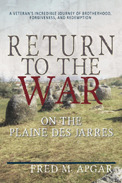
 |
During the Second Indochina War, Apgar served as an air intelligence officer in the U.S. Air Force. He was deployed for a yearlong tour in Laos as part of the “secret war.” Officially, the United States wasn’t involved in Laos. Primarily, Apgar flew in a command plane receiving transmissions from ground troops of the L’Armee Clandestine, mostly comprised of Hmong fighters and Laos troops who were fighting against the Communists. His group also received tactical information from the many other reconnaissance and fighter planes in the area. With this information, those aboard the command plane would direct gunships, bombing runs, and guided strikes to assist those on the ground.
Throughout his tour, he experienced the heroism, professionalism, and sacrifice of those involved. He also began to understand the difficulty of fighting in a secret theater of war and how those restrictions (rules of engagement) hampered the effectiveness of the combined troops. Apgar states, “The restrictions imposed by the ROE cost our nation the lives of many of our servicemen and of our allies.” After finishing his tour, Apgar relates what it was like to return to the States and how he managed his life after the Air Force. Apgar would slowly come to understand how fundamentally important that year in Laos was to him and how much of it he carried with him. In 2014, Apgar was able to make a return to Vietnam and Laos, visit some of the sites familiar to him during his tour of duty, and meet some locals—allies, hostiles, and civilians alike.
Apgar’s memoir has the distinction of being one of a few war memoirs where the author is able to revisit, many years later, the places over which the war was fought and interact with those living in the area. Tim O'Brien is one of the most well-known writers about the Second Indochina War. He has written at least three novels about his experience in Vietnam, including the autobiographical If I Die in a Combat Zone, Box Me Up and Send Me Home, and the more famous short story collection The Things They Carried. It is interesting to contrast these works, as both authors served in this war but in very different roles. O’Brien gives a boots-on-the-ground account of his involvement, whereas Apgar served in a capacity that gave him a more zoomed-out perspective. Both talk about heroism, sacrifice, confusion, and disillusion with differing aspects of the war. The unique perspective available to Apgar as he returns to Laos is enlightening. As he meets former fellow combatants, friendly and enemy, and civilians, including two friends who lost a leg each to American bombs, the connections made are touching and highlight how so many soldiers and civilians just wanted to survive and get back home to take care of their family. The hostility wasn’t personal.
There will undoubtedly be a lot of readers who will find this book interesting. Apgar writes clearly and includes a lot of historical material to help the reader understand the places, the people, the equipment, and the circumstances. There are minor grammatical errors, but none will distract the reader from the experience. The breadth of the work gives the reader a rare and enlightening experience. Clearly, this book will resonate with history lovers and military buffs.
RECOMMENDED by the US Review